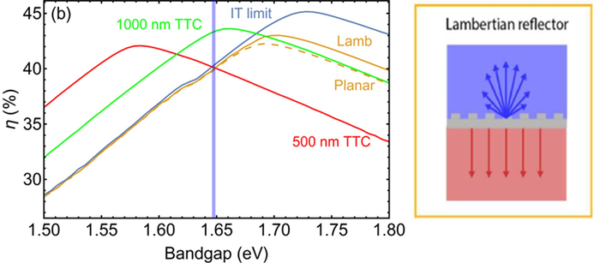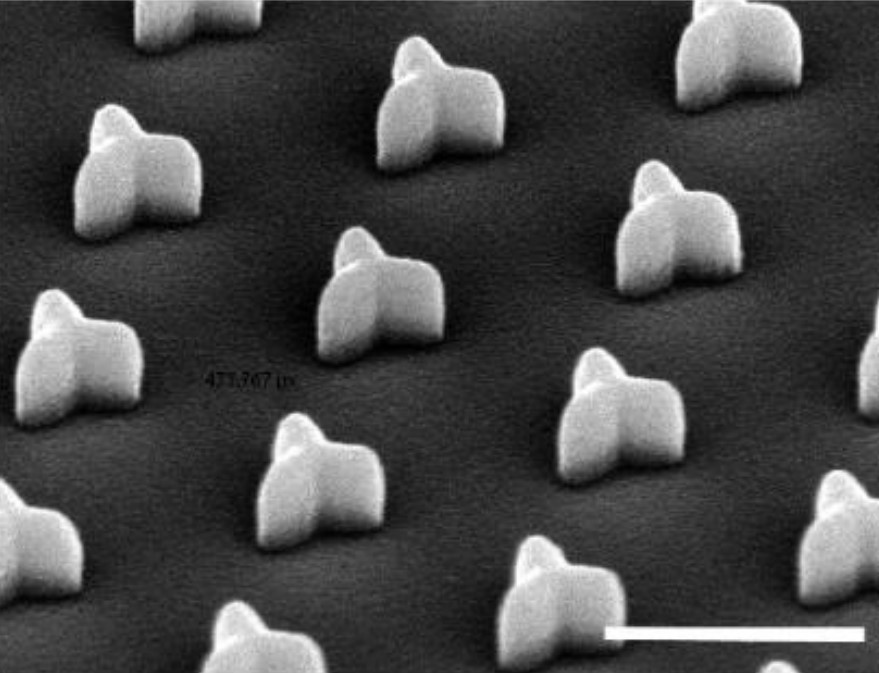Scientists at the University of Waterloo, in Canada, have sought to determine the theoretical maximum efficiencies of different two-terminal (2T) perovskite-silicon tandem solar cells and have demonstrated enhanced efficiencies in cells with a spectral splitter introduced between the top and bottom terminals. “We have already demonstrated similar metasurfaces experimentally in other work on four-terminal perovskite/silicon configurations, together with Solliance and TNO,” the research's corresponding author, Stefan Tabernig, told pv magazine. “In this work, we mainly focused on estimating the potential of the concept from a simulation point of view.”
According to him, integrating optical metasurfaces in tandem for the purpose of spectrum splitting can help with getting closer to the potential maximum efficiency for 2T perovskite-silicon tandem devices, that is estimated at over 45%. “Overall, if issues like the perovskite stability can be overcome, there isn't really anything stopping perovskite/silicon PV from overtaking all current silicon-only PV markets, due to the higher limiting efficiency,” he further explained. “Furthermore, as spectral splitting would specifically benefit perovskite/silicon tandems that use large top cell bandgaps, specific applications such as combined solar cell-water splitting architectures, which require large open-circuit voltages, stand to benefit even more from metasurface spectrum splitters.”
Through their calculations, the scientists found that the use of spectral splitters, when applied to commercially available top cells with energy gaps of 1.73eV, may result in overall efficiency gains of up to 6% if the limit of infinite thickness is set at 500nm for the top cell. “The limiting efficiency gradually decreases as the top-cell bandgap approaches the Si bandgap (1.12 eV), where all light up to that energy is absorbed in the top cell with no current left for the bottom cell,” they highlighted.
Popular content

Image: Neder, Tabernig, and Polman, doi 10.1117/1.JPE.12.015502.
Two kinds of spectral splitters were considered in the study: “planar” and “Lambertian” splitters. The first ones are described as devices that reflect the light specularly back to the top cell and create one extra path for absorption in the top cell, and the second ones are splitters that reflect the light back in a cosine angular fashion such that enhanced light trapping can be achieved in the top cell. “The Lambertian splitter further enhances absorption in the top cell due to the larger angular scattering range and, as a result, less light is lost from the front of the cell. Consequently, the top cell current of the cell with [a] Lambertian spectral splitter is consistently higher than that of the planar spectral splitter while the bottom cell current of both cases is equal,” the academics stated.
According to the research group, the proposed cell architecture should be economically competitive. For a range of between 0.75% and 1.33% efficiency gain per perovskite top cell layer that is added to a silicon bottom cell, previous research estimated manufacturing costs between €0.462 and €0.195/W, respectively. “The referenced range for c-Si modules goes from €0.25 to €0.30/W, which shows that perovskite/Si tandems can be economically interesting,” Tabernig emphasized. “Assuming similar costs for the fabrication steps, and no significant loss in spectrum splitting performance with upscaling, the efficiency gains per fabricated layer found in this work lie within an economically competitive range.”
The cell design was described in the study “Detailed-balance efficiency limits of two-terminal perovskite/silicon tandem solar cells with planar and Lambertian spectral splitters,” published in Photonics Energy. “Overall, our work shows there is a bright perspective for the integration of spectral splitters in perovskite-Si tandem solar cells, even if unity reflectivity cannot be achieved experimentally,” the scientists concluded.
This content is protected by copyright and may not be reused. If you want to cooperate with us and would like to reuse some of our content, please contact: editors@pv-magazine.com.



By submitting this form you agree to pv magazine using your data for the purposes of publishing your comment.
Your personal data will only be disclosed or otherwise transmitted to third parties for the purposes of spam filtering or if this is necessary for technical maintenance of the website. Any other transfer to third parties will not take place unless this is justified on the basis of applicable data protection regulations or if pv magazine is legally obliged to do so.
You may revoke this consent at any time with effect for the future, in which case your personal data will be deleted immediately. Otherwise, your data will be deleted if pv magazine has processed your request or the purpose of data storage is fulfilled.
Further information on data privacy can be found in our Data Protection Policy.